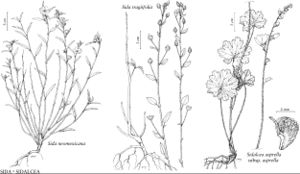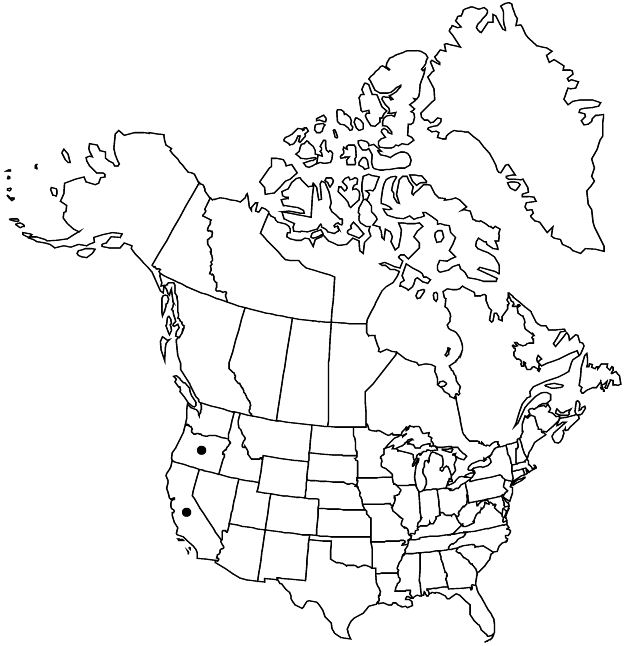Sidalcea asprella subsp. asprella
Plants (0.3–)0.5–1(–1.2) m, with caudex or usually compact rootstocks or rhizomes to 10(–30) cm × 4 mm. Stems erect, sometimes supported by other vegetation, sometimes proximally decumbent and often rooting to erect, roughly minutely- or long-stellate-hairy, hairs spreading, usually on swollen bases, minutely hairy to glabrate distally. Leaves mostly cauline, evenly distributed, not concentrated at stem base, gradually reduced distally; petiole (1–)5–10(–15) cm, those of proximal leaves 4 times as long as blade, reduced distally to 1/2 times to as long as blade; blades: proximal usually lobed, distal palmately (5–)7-lobed, (3–)5–12(–15) cm wide, base with wide sinus to truncate, margins crenate-serrate, lobe tips oblong, usually 3-toothed (sometimes entire), distalmost 3–5-parted; surfaces stellate-puberulent, sometimes with some simple hairs. Inflorescences erect, unbranched or branched, 8–15(–30)-flowered, sometimes 1-sided; proximalmost bract usually leaflike, 15 × 12 mm, distal bracts linear, 3 mm, shorter than pedicel. Pedicels 2–5(–10) mm. Flowers: calyx 5–7 mm, to 7–10 mm in fruit; petals pink to pale purple, pistillate usually (5–)10–15 mm, bisexual (15–)20–25 mm; stigmas (6 or)7 or 8. Schizocarps 6–8 mm diam.; mericarps (6 or)7 or 8, 3–4 mm; prominently reticulate-veined, pitted, margins and back rugose-pitted but less so on back, sometimes glabrous, mucro 0.5–0.8 mm. Seeds 1.5 mm. 2n = 20, 40, 60.
Phenology: Flowering (Apr–)May–Jun(–Jul).
Habitat: Open woodlands, wet meadow margins, foothill woodlands, conifer forests, sometimes serpentine
Elevation: 200–1000(–1800) m
Discussion
Subspecies asprella has been confused with subsp. nana, Sidalcea celata, S. elegans, and S. glaucescens, and it previously has been placed within S. malviflora. Taller individuals can be confused with S. celata and S. gigantea; the adaxial leaf surfaces of S. celata generally have simple or two-branched hairs and those of the others have stellate hairs. Sidalcea gigantea always has long, retrorse bristle hairs at the stem base, and well-developed rhizomes. Sidalcea celata usually has dense, short, retrorse simple hairs at the stem base and rarely some stellate hairs; subsp. asprella always has stellate hairs at the stem base, but they can be less dense and short-scabrous or longer and softer. All three taxa occur in Shasta County, California, and some specimens from there may not be easily determined to species; young plants of S. gigantea may be easily mistaken as subsp. asprella before the stems and rhizomes are fully developed, and the fruits essentially match in both species. Subspecies asprella appears to be replaced by subsp. nana in northern California and Oregon, and it is especially difficult to be certain of identifications in that area.
Selected References
None.

